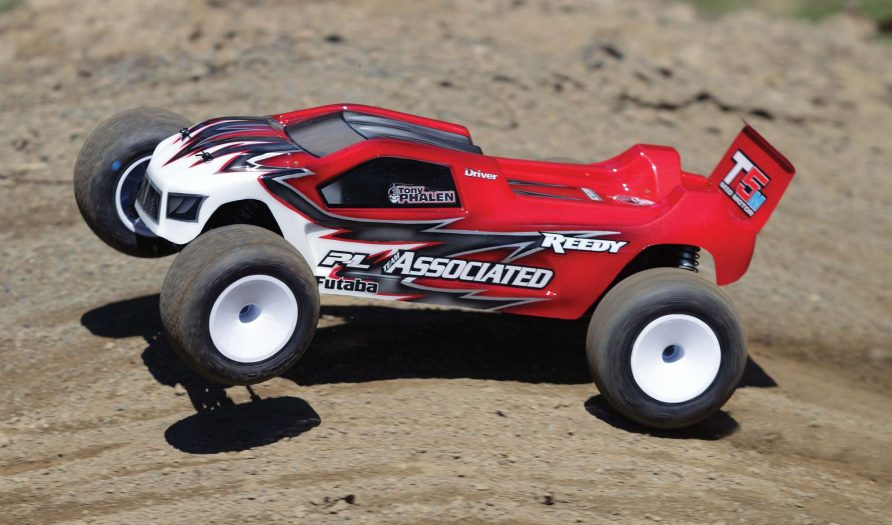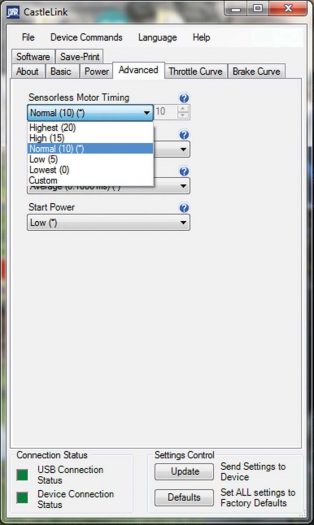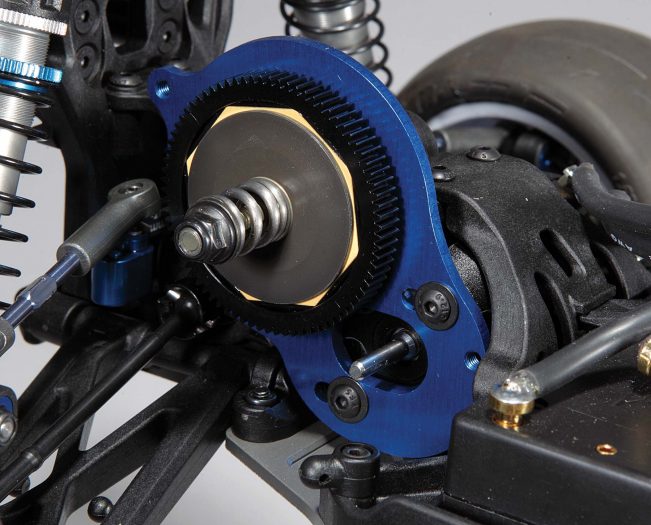This article was originally published in RC Driver’s October 2015 issue.
By Scott Donaldson
One of the really neat features about brushless motors is the option to adjust the timing to change the performance of a motor. There are a lot of different ways to adjust the timing on a brushless system. Some motors allow you to adjust timing right on the motor itself; other systems allow you to adjust the timing through the ESC. Any time you adjust the timing you change the power band of your motor and you need to adjust your gearing accordingly. But how and why do you need to change? That’s what we’re going to cover for you right here.
WHAT IS TIMING ANYWAY?
When we talk about timing on a brushless motor system it is in terms of how and when the coils of wire are charged as the stator spins inside the can. Increasing the timing in your motor or ESC increases this margin. Generally speaking increasing the timing on your motor or ESC will increase the RPMs of your motor system, however this comes at a cost. When you increase the timing and the RPM you’ll generally decrease the bottom end torque and punch of your motor and ESC system. The opposite is also true where if you decrease the timing in the motor or ESC you’ll reduce the RPMs but you’ll see an increase in bottom-end torque. It is all a balancing act and often increasing the timing will cost you speed and increase running temperatures. This is where adjusting your gearing properly will ensure you get the performance you desire.
GEARING OVERVIEW
Any time we’re talking about gearing we’re talking about some sort of ratio. It’s often the tooth count on the spur gear divided by the tooth count on your pinion gear and that number multiplied by the final drive ratio (FDR) of your car’s transmission. So for example let’s say you’re running an 88T spur gear with a 25T pinion and the final drive on your transmission is 2.52. This is how you figure out your end gear ratio:
88/25= 3.52:1
This means that for every one time that the spur gear rotates completely your pinion gear needs to rotate 3.52 times. Now we take our 3.52 and multiply it by our transmission final drive ratio and we get:
3.52 x 2.52 = 8.8704:1
So for every one rotation of the axle/outdrive/wheel the pinion gear rotates 8.8704 times. You can increase or decrease your pinion or spur gear tooth count to alter the gear ratio of your vehicle. Using a smaller pinion gear or larger spur gear will increase initial acceleration and torque but yield a lower overall top speed. If you use a larger pinion or smaller spur gear you will have less acceleration and torque but your overall top speed will increase. It’s all a balancing act and you’ll need to tune carefully.
GEARING AND TIMING
So we know from our above example that increasing timing increases RPM and decreases torque. We also know what effects changing a pinion or spur gear have. It’s time to bring these two pieces together. So let’s say that our example final gear ratio of 8.8704:1 from above is what we would normally gear a motor at with 20 degrees of timing in the system. If we were to increase the timing to 35 degrees then we should decrease the size of our pinion or increase our spur gear size to remain within the proper power band of the motor and ESC.
Originally in this example we had a 25T pinion on the motor. With an increase in timing of 15 degrees a 3-5 tooth drop would be a good start. So let’s get out the pencil and paper and see what the new gearing is: 88/20 = 4.4:1
So right here we can see how our pinion and spur ratio changed from 3.52:1 to 4.4:1.
That means that the pinion will now rotate 4.4 times for every one rotation of the spur gear. 4.4 x 2.52 = 11.088
Here we can see our final gear ratio has jumped up to 11.088 from 8.8704. Some of you may wonder if this won’t make the car or truck slower and the answer is it depends. We’re adjusting the gearing to suit the RPM and power band of the motor. As you increase the timing you increase the RPMs so realistically this 11.088 ratio with more timing should have similar to better top speed and better acceleration. Timing and gear ratios are a powerful tuning tool!
That’s how you adjust your gearing if you increase the timing. What about if you decrease the timing? Decreasing the timing lowers the power band to increase torque. Basically you can pull a bigger pinion gear or smaller spur gear with less timing, generally speaking. If you are driving on slicker surfaces and having problems hooking up the power this can help hook things up more easily. So let’s say that we decrease our timing from our 20 degree starting spot to 10 degrees. Normally a 2-3T increase in pinion size would be appropriate for something like this. So once again: 88/28 = 3.14:1 Now the pinion gear only needs to rotate 3.14 times for each full rotation of the spur gear. 3.14 x 2.52 = 7.92:1 As you can see the final gear ratio is quite a bit lower than our original starting spot. This should yield a slightly softer accelera- tion rate than the higher ratios but have a little more top speed.
CONCLUSION
Gearing and timing go hand-in-hand. If you adjust one you really need to adjust the other to maintain a proper balance and not over- heat or potentially damage your equipment. It may take some trial and error to find the sweet spot in your gearing but once you do you’ll be thrilled with the performance of your car or truck. You’ll also notice that your electronics run cooler when you are geared properly because your motor isn’t struggling in an over geared situation or over-revving in an under geared situation. The best thing you can do is to buy an assortment of pinions and spur gears and change something every run. You’ll definitely learn something new with each test run you make!
 RC Driver The Best In RC Car & Truck News, Reviews & Video
RC Driver The Best In RC Car & Truck News, Reviews & Video 










